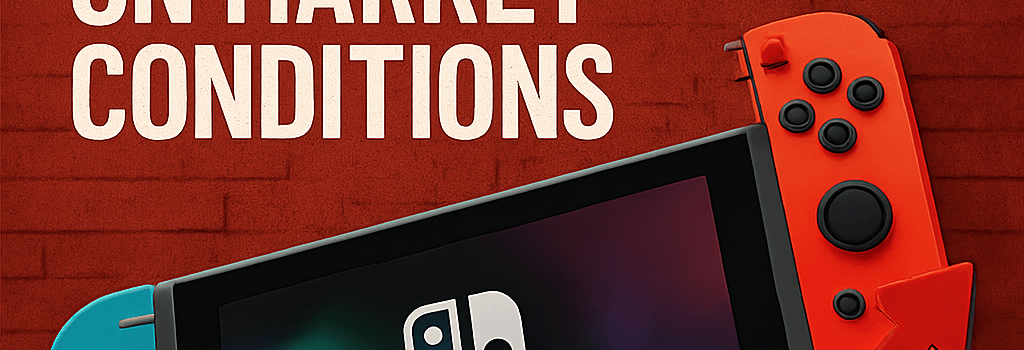Nintendo Blames Switch Price Hike on Market Conditions

By [Your Name] — Updated Aug 1, 2025
Overview of the Price Change
Effective August 3, Nintendo will increase the retail prices of its original Switch handheld console, certain Amiibo figures, the Alarmo clock, and a selection of Switch and Switch 2 accessories. The company has stated that this adjustment is driven by prevailing “market conditions,” but industry analysts point to escalating tariffs, component shortages, and logistics costs as primary catalysts.
Specific Price Adjustments
- Switch Lite: Raised from $199.99 to $229.99
- Original Switch: Raised from $299.99 to $339.99
- Switch OLED: Raised from $349.99 to $399.99
- Joy-Con 2 Controllers: Increased from $95 to $100
- Standard Joy-Con: Increased from $80 to $90
- Amiibo & Accessories: Variable increases up to 15%
Note: Prices for Switch 2 console, Nintendo Online memberships, and both physical and digital Switch 2 titles remain unchanged “at this time.”
Technical Breakdown: Why Costs Are Rising
The original Nintendo Switch launched in 2017 on an NVIDIA Tegra X1 SoC, featuring a 4-core ARM Cortex-A57 CPU cluster, 256-core Maxwell GPU, 4 GB of LPDDR4 RAM, and 32 GB eMMC internal storage (expandable via microSD). Key components—including DRAM, flash storage, and display drivers—have seen global price inflation of up to 20% since late 2023.
“The combination of sustained semiconductor shortages and higher shipping costs due to new de minimis tariff rules is squeezing margins across the board,” says Monica Patel, senior analyst at IDC.
Impact of U.S. Tariff Policy
In May and June 2025, the U.S. administration imposed a fresh 7.5–25% tariff on electronics assembled in Thailand, India, Cambodia, and Vietnam—nations to which many companies, including Nintendo’s manufacturing partners, shifted production following earlier China‐focused measures. Additionally, the blanket de minimis exemption for shipments under $800 was rescinded for all regions, eliminating a key cost-saver for small electronics and accessories.
Global Supply Chain Analysis
Nintendo’s supply chain spans Asia—principal assembly in Vietnam and selected component fabrication in Japan. Rising labor costs, compounded by stricter environmental regulations in Southeast Asia, have driven up unit manufacturing expenses by roughly 5–8%. Freight rates on major trade lanes (Asia→North America) have jumped over 30% year-over-year, according to the Freightos Baltic Index.
Competitive Pricing Landscape
- Microsoft Xbox Series X/S: Series X increased by $50 to $649; Series S now $349.
- Sony PlayStation 5: Digital Edition remains at $399; Disc Edition unchanged at $499.
Unlike Sony’s static PS5 pricing, both Nintendo and Microsoft have signaled future adjustments may be necessary if economic conditions persist.
Additional Insights: Hardware Lifecycle & Backward Compatibility
While the Switch 2—powered by a custom NVIDIA Tegra Orin chip, 8 GB LPDDR5 RAM, and a 1080p/60 Hz handheld display—is the company’s flagship, Nintendo maintains the original Switch as an entry-level SKU. This tiered approach sustains affordability for budget-conscious consumers, even as hardware ages. Upcoming titles such as Metroid Prime 4 and Pokémon Legends: Z-A will ship in dual editions, ensuring broad compatibility across the Switch family.
Expert Opinion: Long-Term Outlook
“Nintendo’s decision to hold Switch 2 pricing steady while adjusting older models is a strategic pivot to protect next-generation sales volumes,” notes Jason Lin, gaming hardware strategist at NPD Group. “However, persistent inflation could eventually spur hikes on all SKUs.”
Future-Proofing Nintendo’s Strategy
To mitigate cost pressures, Nintendo is reportedly exploring:
- Vertical integration of chip production with third-party foundries
- Dynamic pricing models tied to currency fluctuations
- Localized assembly hubs in South America and Eastern Europe
Conclusion
Nintendo’s August price adjustment for the original Switch series underscores broader economic headwinds—from trade policy shifts to semiconductor bottlenecks—reshaping the console market. While core next-gen prices remain stable, consumers and retailers alike should brace for further volatility in 2026.